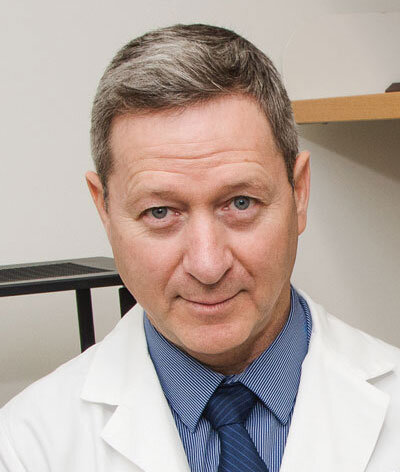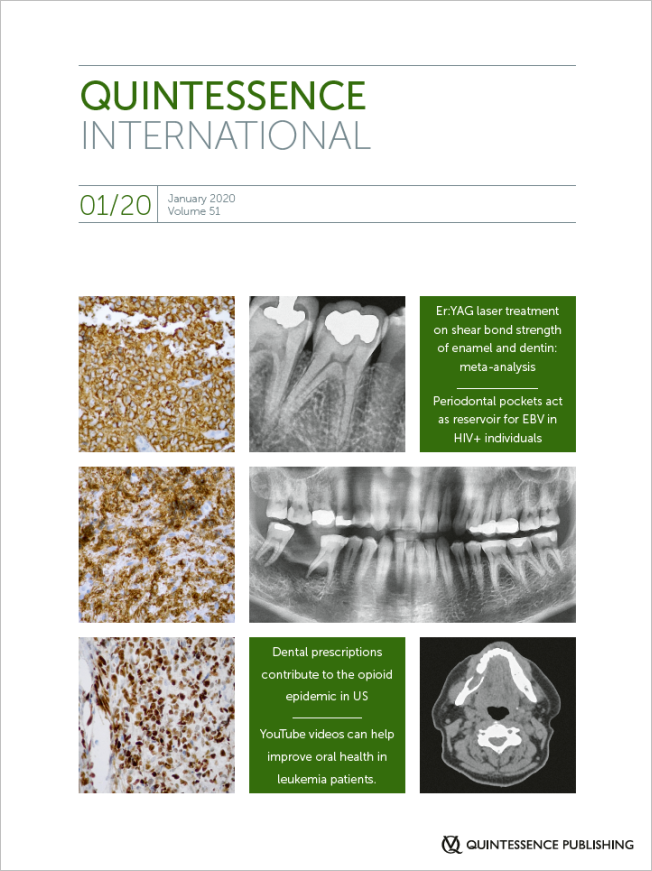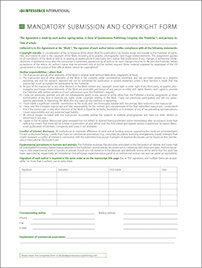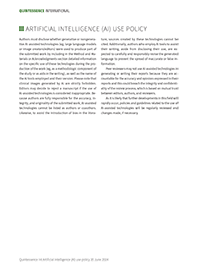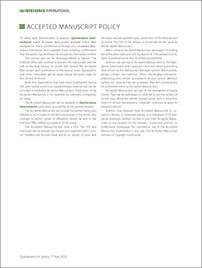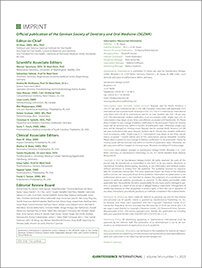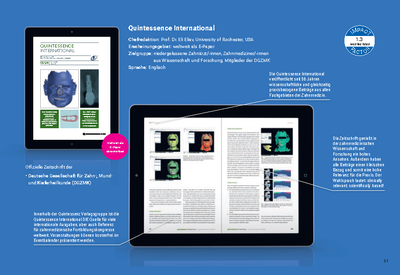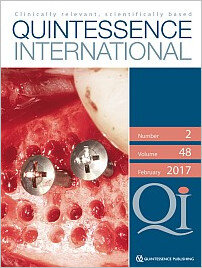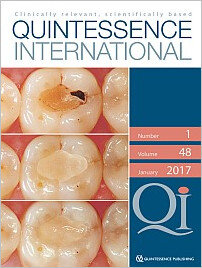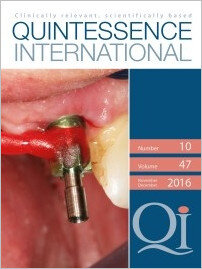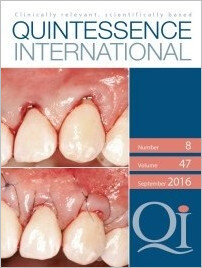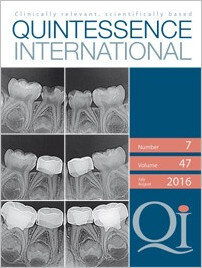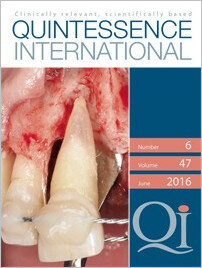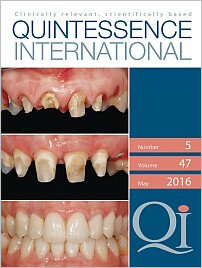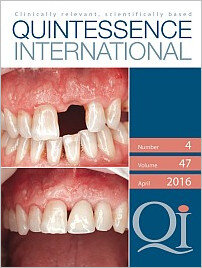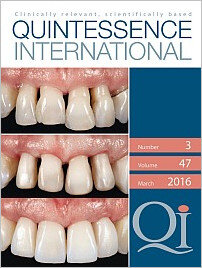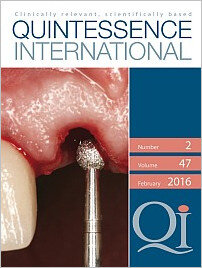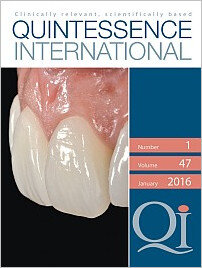DOI: 10.3290/j.qi.a37645, PubMed ID (PMID): 28133643Pages 91, Language: EnglishEliav, EliDOI: 10.3290/j.qi.a37386, PubMed ID (PMID): 27981270Pages 93-101, Language: EnglishAlonso, Víctor / Darriba, Iria L. / Caserío, MartínObjective: The aim of this retrospective study was to evaluate the long-term clinical outcomes of posterior composite resin sandwich restorations, and secondarily to assess the influence of potential factors on survival and causes of failure.
Method and Materials: Two hundred and four posterior Herculite XRV restorations due to primary caries performed between 1991 and 1997 were included. The restorations were assessed after 18 years, by two calibrated examiners, according to USPHS criteria. The survival of the restorations was estimated by the Kaplan-Meier estimator. Cox regression was applied to evaluate the influence of the cavity size, location of the tooth, caries risk, and gender on survival rate. The predictive power of the analyzed variables on survival rate was studied with multiple linear regression analysis.
Results: After 10 years the survival rate was 92.6%, and 82.4% at the end of the study. Thirty-six (17.6%) restorations failed during the evaluation period, 21 (10.3%) of them after more than 10 years. The most common failure was secondary caries (69.4% of the failures). There were statistically significant differences in survival rate depending on caries risk (P = .000), but not between Class I and II (P = .106), and the type and localization of the tooth (P = .115).
Conclusion: Posterior Herculite XRV restorations due to primary caries have high long-term survival rates. Generally, failures occur by secondary caries and are more common in molars. The patient's caries risk is the variable that best predicts the survival of posterior restorations.
Keywords: caries, clinical evaluation, composite resin, longevity, posterior restoration, survival rate
DOI: 10.3290/j.qi.a37387, PubMed ID (PMID): 28133644Pages 103-111, Language: EnglishClark, Danielle / Febbraio, Maria / Levin, LiranAggressive periodontal disease is an oral health mystery. Our current understanding of this disease is that specific bacteria invade the oral cavity and the host reacts with an inflammatory response leading to mass destruction of the alveolar bone. Aggressive periodontal disease is typically observed in a population under the age of 30 and occurs so rapidly that it is difficult to treat. Unfortunately, the consequence of this disease frequently involves tooth extractions. As a result, the aftermath is chewing disability and damage to self-esteem due to an altered self-image. Furthermore, patients are encumbered by frequent dental appointments which have an economic impact in regards to both personal financial strain and absent days in the workplace. Aggressive periodontal disease has a tremendous effect on patients' overall quality of life and needs to be investigated more extensively in order to develop methods for earlier definitive diagnosis and effective treatments. One of the mysteries of aggressive periodontal disease is the relatively nominal amount of plaque present on the tooth surface in relation to the large amount of bone loss. There seems to be a hidden factor that lies between the response by the patient's immune system and the bacterial threat that is present. A better mechanistic understanding of this disease is essential to provide meaningful care and better outcomes for patients.
Keywords: bone, bone loss, gingival health, juvenile periodontitis, plaque
DOI: 10.3290/j.qi.a37132, PubMed ID (PMID): 27834418Pages 113-122, Language: EnglishBaldodia, Aastha / Sharma, Rajinder Kumar / Tewari, Shikha / Narula, Satish ChanderObjective: Chronic periodontitis (CP) is associated with increased systemic inflammation and osteoporosis. Pro-inflammatory cytokines, implicated in systemic bone loss, are also associated with periodontitis. The impact of control of systemic inflammation by scaling and root planing (SRP) on bone mineral density (BMD) in postmenopausal (PM) osteopenic women with CP was investigated in this study.
Method and Materials: Sixty-eight PM osteopenic women with CP were included. The test group (n = 34) received SRP along with calcium (500 mg) and vitamin D (250 IU) supplementation twice a day for 6 months, while the control group (n = 34) received calcium (500 mg) and vitamin D (250 IU) supplementation twice a day for 6 months. BMD, serum high sensitivity C-reactive protein (hsCRP), and periodontal parameters were recorded at baseline and 6 months.
Results: Improvement in BMD and serum hsCRP showed a statistically significant difference between groups at 6 months (P .001). Binomial logistic regression analysis revealed that the test group was 4.82 (ORadjusted = 4.82; 95% CI = 1.17-19.71; P = .029) times more likely to exhibit normal BMD at 6 months. The results suggest there is an association of control of systemic inflammation by SRP with improved BMD in PM osteopenic women with generalized severe CP.
Keywords: bone density, chronic periodontitis, menopause, osteoporosis
DOI: 10.3290/j.qi.a37384, PubMed ID (PMID): 27981268Pages 123-130, Language: EnglishAl Habashneh, Rola / Farasin, Rawan / Khader, YousefObjective: The daily removal of supragingival dental plaque is a key factor in the prevention of gingivitis. The aim of the study was to compare the gingival health benefits of a triclosan/copolymer/fluoride toothpaste (Colgate Total, a fluoride toothpaste containing an antiseptic) to a commercially available toothpaste containing 0.243% sodium fluoride in a silica base (Colgate Herbal, a conventional fluoride toothpaste with herbal extracts).
Method and Materials: A total of 50 patients with gingivitis and at least one sensitive tooth were included. The subjects were randomly stratified into two groups: Colgate Total toothpaste, and Colgate Herbal toothpaste. After a 4-week pre-experimental phase, baseline Plaque Index (Quigley-Hein Index) (PI), Gingival Index (GI), Gingival Bleeding Index (GBI), and Visual Analog Scale (VAS) were assessed. The PI, GI, GBI, and VAS were reexamined at weeks 4, 12, and 24 after the baseline.
Results: Fifty subjects complied with the protocol and completed the study. The conventional fluoride toothpaste with herbal extracts group and the fluoride toothpaste containing an antiseptic group exhibited significant reductions in PI, GI, GBI, and VAS over time. The amount of reduction after 6 months of the treatment was higher in the Total group compared to Herbal group (1.82 vs 1.39, P = .015 for PI; 0.67 vs 0.37, P .005 for GI; and 56.64% vs 34.26%, P .005 for GBI). No significant difference was seen for VAS.
Conclusion: Twice daily brushing with a toothpaste containing 0.3% triclosan and polyvinyl methyl ether and maleic acid copolymer provides a more effective level of plaque control and gingival health with no effect on decreasing dentin hypersensitivity compared to conventional fluoride toothpaste. Toothpastes containing triclosan/copolymer, in addition to fluoride, result in a higher reduction in plaque, gingival inflammation, and gingival bleeding when compared with fluoride toothpastes without triclosan/copolymer.
Keywords: bacteria, gingivitis, Jordan, plaque, toothpaste, triclosan
DOI: 10.3290/j.qi.a37133, PubMed ID (PMID): 27834419Pages 131-147, Language: EnglishSoldatos, Nikolaos K. / Stylianou, Popi / Koidou, Vasiliki P. / Angelov, Nikola / Yukna, Raymond / Romanos, Georgios E.Objective: Deficient bony ridges often complicate the implant treatment plan. Several treatment modalities are used to regenerate bone, including guided bone regeneration (GBR). The purpose of this study was to summarize the knowledge on different types of membranes available and currently used in GBR procedures in a staged approach or with simultaneous implant placement. The primary role of the membranes is to exclude epithelial and connective tissue cells from the wound area to be regenerated, and to create and maintain the space into which pluripotential and osteogenic cells are free to migrate.
Data
Sources: A literature search was performed for articles that were published in English on the topic. A selected number of studies were chosen in order to provide a review of the main characteristics, applications, and outcomes of the different types of membranes. Resorbable membranes are made of natural or synthetic polymers like collagen and aliphatic polyesters. Collagens are the most common type used. They have similar collagen composition to the periodontal connective tissue. Other materials available include human, porcine, and bovine pericardium membranes, human amnion and chorion tissue, and human acellular freeze-dried dermal matrix. Nonresorbable membranes used in GBR include dense-polytetrafluoroethylene (d-PTFE), expanded-polytetrafluoroethylene (e-PTFE), titanium mesh, and titanium-reinforced polytetrafluoroethylene.
Conclusions: The most common complication of nonresorbable membranes is exposure, which has detrimental effect on the final outcome with both types of membranes. For vertical bone augmentation procedures, the most appropriate membranes are the nonresorbable. For combination defects, both types result in a successful outcome.
Keywords: alveolar ridge augmentation, membranes, nonresorbable, resorbable
DOI: 10.3290/j.qi.a37383, PubMed ID (PMID): 27981267Pages 149-153, Language: EnglishShimizu, Rikuka / Ohga, Noritaka / Miyakoshi, Masaaki / Asaka, Takuya / Sato, Jun / Kitagawa, YoshimasaChanges in facial bones may represent a manifestation of systemic disease. Dentists play an important role in the early detection of these manifestations of complex systemic diseases. A case of unusual maxillary mixed (osteoblastic and osteolytic) lesions as an initial manifestation of childhood acute myeloid leukemia (AML) is presented. A 12-year-old male patient was referred to the Department of Oral Medicine complaining of severe swelling in the right buccal region. 18F-fluorodeoxyglucose (FDG)-positron emission tomography (PET)/computed tomography (CT) showed enhanced FDG uptake in the right maxillary sinus. In addition, PET maximum intensity projection image showed diffused FDG uptake in the entire bone marrow. Bone marrow aspiration was performed on the lumbar vertebra, and fluorescence in situ hybridization (FISH) demonstrated AML. The patient was diagnosed with AML (M5a) and treated with chemotherapy by the pediatric department. Six months later, the patient achieved complete remission. After chemotherapy, the disappearance of the osteoblastic and osteolytic lesion and 18F-FDG accumulation were confirmed by PET/CT. Dentists should be familiar with oral manifestations of leukemia because early detection of oral lesions would increase the life span of the patients and reduce the severity of complications.
Keywords: leukemia, mixed lesion, oral manifestation, osteoblastic, osteolytic
DOI: 10.3290/j.qi.a37385, PubMed ID (PMID): 27981269Pages 155-159, Language: EnglishSchemel-Suárez, Mayra / López-López, José / Chimenos-Küstner, EduardoThe causes of dental pigmentation are diverse. It can be classified in intrinsic or extrinsic depending on the origin and location of the stain in the affected tooth. This report presents an unusual case of dental pigmentation and enamel loss where the diagnosis of its origin revealed an underlying systemic pathology, unknown to the patient, which could have affected the development of the pigmentation.
Keywords: dental pigmentation, diagnosis, discoloration, hemochromatosis, iron overload, tooth wear
DOI: 10.3290/j.qi.a37152, PubMed ID (PMID): 27834421Pages 161-171, Language: EnglishStrickland, Maxine / Duda, Peter / Merdad, Hisham E. / Pelaez-Shelton, Rosa E. / Rosivack, R. Glenn / Markowitz, KennethObjective: Caries risk assessment is an important component of clinical practice. The goal of this project was to evaluate the diagnostic performance of two commercially available kits (the Saliva-Check mutans and the Plaque-Check pH kit; GC-America) in distinguishing caries-active from caries-free individuals. The effect of following instructions not to eat, drink, or perform oral hygiene, prior to testing, was also investigated on the effectiveness of these kits.
Method and Materials: The subjects included 26 caries-affected children and 20 caries-free adults. Plaque and saliva samples were collected for analysis by the two kits following the manufacturer's instructions. For 63 additional subjects, instructions not to eat, drink, or practice oral hygiene were omitted prior to sample collection. The sensitivity and specificity in distinguishing caries-free from caries-active subjects was calculated for both kits.
Results: The sensitivity (88%) and specificity (90%) of the Saliva-Check mutans kits were satisfactory in the subjects refraining from eating etc. In contrast, both the sensitivity and the specificity of this kit were reduced when subjects were tested without use instructions. When tested in subjects that followed instructions, the pH kit's sensitivity and specificity were 72% and 55% respectively. This modest diagnostic performance was reduced when pH values were measured in subjects not following use instructions.
Conclusion: These kits, particularly the Saliva-Check mutans kits, can contribute to patient education by documenting microbial caries risk factors. Though difficult to implement in practice, subjects should refrain from eating or other activities that disturb the oral environment prior to sample collection.
Keywords: caries risk assessment, patient education, plaque pH chairside test, Streptococcus mutans test



